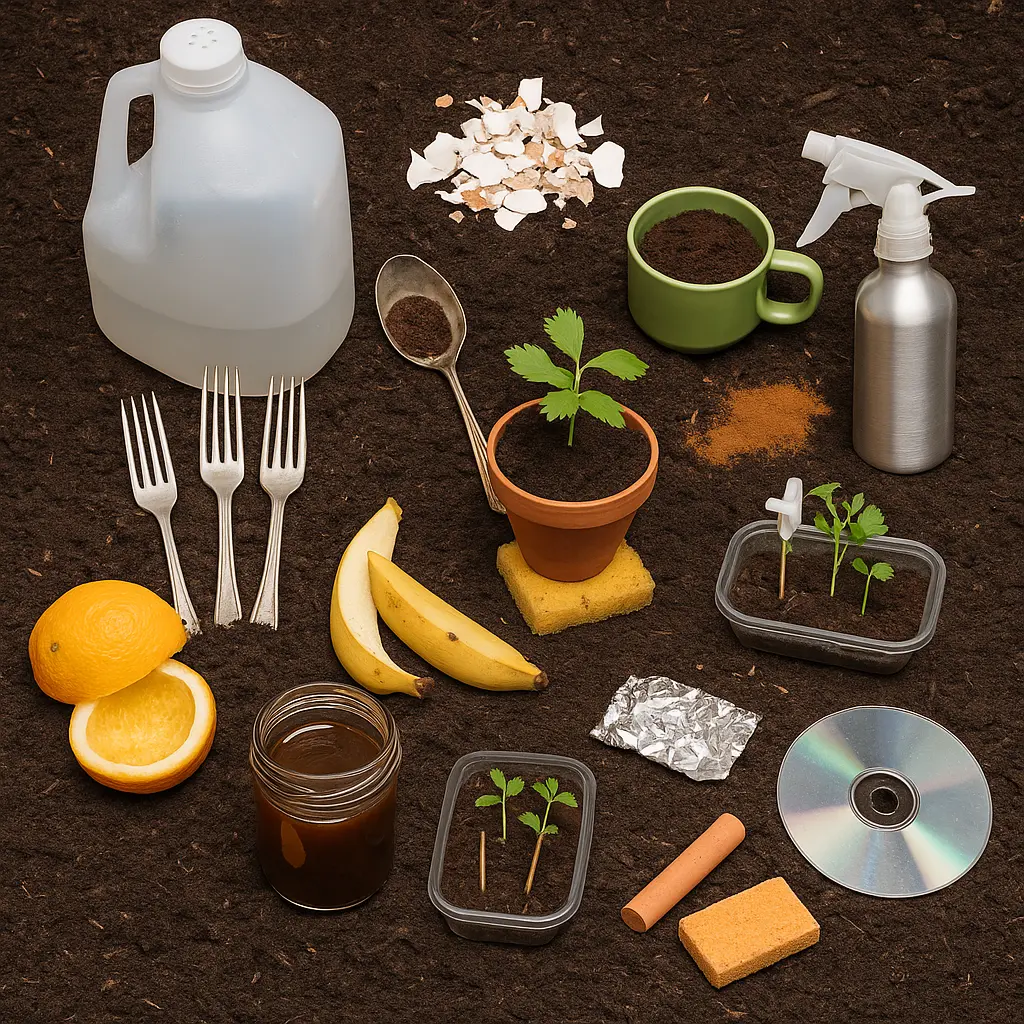Gardening doesn’t always require expensive tools, fancy fertilizers, or store-bought solutions. In fact, some of the best fixes for common garden problems are already sitting in your kitchen or around your home. From boosting soil health to repelling pests and even protecting fragile seedlings, everyday household items can make a surprising difference in the way your garden grows. The beauty of these hacks is their simplicity—most cost nothing, reduce waste, and offer practical results that you can see quickly. Whether you’re a beginner gardener or someone with years of experience, these clever ideas will help you save time, money, and effort while keeping your garden thriving.
1. Eggshells to Boost Soil Calcium
Eggshells are one of those kitchen scraps that most people throw away without realizing how valuable they can be in the garden. When crushed and sprinkled around plants, they become a natural source of calcium, slowly enriching the soil and helping prevent blossom-end rot in tomatoes and peppers. I’ve noticed that when I use them regularly, my tomato harvest tends to look healthier and less prone to black spots at the bottom. Another bonus is that the sharp edges of crushed shells discourage slugs and snails, giving your plants an extra layer of protection. Instead of tossing them, simply rinse, dry, and crush before spreading around your garden beds.
2. Coffee Grounds as Fertilizer and Pest Repellent
If you’re a coffee drinker, your garden can benefit from that daily ritual. Used coffee grounds are rich in nitrogen and organic matter that improves soil texture and feeds plants. They work especially well for acid-loving plants like blueberries, hydrangeas, and roses. On top of that, their scent repels ants, cats, and some other unwanted visitors. I’ve found that sprinkling a thin layer around my plants keeps neighborhood cats from turning flower beds into their litter box. For best results, you can mix the grounds into compost or scatter them lightly around plant bases without piling them too high.
3. Milk Jugs for DIY Watering Cans
Not having a watering can doesn’t have to slow you down in the garden. With an empty milk jug and a few small holes poked in the cap, you can make a homemade sprinkler in minutes. It’s surprisingly effective for watering delicate seedlings without drowning them. I once used this trick when my watering can broke, and honestly, the jug worked so well I kept using it even after buying a new one. Adjusting the number of holes in the cap lets you control how much water flows out, making it flexible for different garden needs.
4. Plastic Forks to Deter Pests
Gardeners know the frustration of waking up to find freshly planted beds disturbed by birds, squirrels, or even the neighbor’s cat. An inexpensive and harmless way to deter them is by sticking old plastic forks in the soil with the tines pointing upward. It creates a simple barrier that makes digging far less appealing. I tried this after losing a row of seedlings to squirrels, and the difference was immediate—no more soil disturbances. To make it effective, space the forks about six to eight inches apart so pests can’t sneak through easily.
5. Old Sponges for Better Drainage
Instead of tossing worn-out sponges, you can use them to improve plant pot drainage. Placing a sponge at the bottom of a pot allows it to soak up excess water and slowly release it as the soil dries out. This prevents water from pooling and stops soil from leaking out of the drainage holes. It’s particularly handy for houseplants that are prone to root rot if left sitting in soggy soil. When I started using this trick, my potted herbs seemed to thrive longer between waterings. Just remember to replace the sponges every few months to prevent mold buildup.
6. Vinegar Spray for Weeds
Weeds can quickly take over driveways, sidewalks, and even garden rows, but harsh chemical herbicides aren’t the only solution. White vinegar is an inexpensive, natural way to dry out unwanted plants. It works best when sprayed directly on weeds during sunny days because the heat accelerates the process. I once cleared a stretch of patio cracks with nothing more than vinegar, and the weeds didn’t come back for weeks. Just be careful when using it near your vegetables or flowers, since vinegar doesn’t discriminate and can harm them too if sprayed directly.
7. Old Spoons and Forks as Garden Markers
Instead of buying plastic plant labels, you can turn old cutlery into charming and durable garden markers. Simply write or paint the plant names on the handles and stick them into the soil. They’re sturdy enough to withstand rain and sun, and they add a bit of rustic character to the garden. I love that this idea turns clutter in the kitchen drawer into something useful outside. For a playful touch, you can spray paint the utensils in bright colors before labeling, or leave them as they are for a more natural, vintage look.
8. Banana Peels for a Potassium Boost
Banana peels are more than just compost material—they’re packed with potassium and phosphorus, which are essential for plant growth and flower production. Instead of throwing them away, chop the peels into small pieces and bury them a few inches into the soil around your plants. Over time, they decompose and release nutrients right where the roots need them. I noticed my roses bloomed more vibrantly when I started using banana peels in the soil. It’s a simple way to give plants a natural fertilizer without spending extra money.
9. Newspaper Mulch to Retain Moisture
Old newspapers can serve as an excellent mulch to keep soil moist and suppress weeds. By layering sheets of damp newspaper around your plants, you create a barrier that blocks sunlight from reaching weed seeds while locking in moisture for your crops. I once covered an entire raised bed with newspapers and topped it with straw, and it kept the weeds down all summer long. Just make sure to avoid glossy or colored pages, and use plain black-and-white print for a safe and eco-friendly solution.
10. Epsom Salt for Greener Plants
Epsom salt, which is actually magnesium sulfate, can give your plants a quick nutrient boost. Magnesium helps with chlorophyll production, resulting in greener, healthier leaves. Dissolve a tablespoon of Epsom salt in a gallon of water and use it to water plants like tomatoes, peppers, or roses every few weeks. I tried this trick when my pepper plants looked a little pale, and within days, the leaves perked up and turned a deep green. It’s an easy fix that works wonders without the need for expensive fertilizers.
11. Baking Soda for Sweeter Tomatoes
If you want tomatoes with a naturally sweeter flavor, try sprinkling a small amount of baking soda around the base of your plants. The baking soda lowers the soil’s acidity, which can make tomatoes taste less tart and more balanced. I experimented with this method in a small corner of my garden, and the difference was noticeable—the tomatoes had a smoother, sweeter taste compared to the rest. Just be careful not to overdo it, as too much can alter soil health in the long run.
12. Toothpicks to Support Seedlings
Fragile seedlings often struggle to stand tall, especially when grown indoors before transplanting. A few toothpicks can act like tiny stakes, helping them stay upright until they grow stronger stems. I used this trick when starting basil seeds on my windowsill, and it kept them from bending and breaking under their own weight. Just place two or three toothpicks around each seedling and gently tie with a piece of thread or kitchen twine for extra support.
13. Aluminum Foil to Reflect Sunlight
Shiny aluminum foil can help plants get more light, especially in shaded areas of your garden or indoors. Simply line the inside of a box or place sheets of foil behind your plants to reflect sunlight back onto them. I tried this in early spring when my seedlings weren’t getting enough natural light, and it made a huge difference in their growth. The foil doesn’t just brighten their space—it also helps deter certain pests like aphids when placed around the base of plants.
14. Citrus Peels to Keep Cats Away
If you’ve got cats that like to dig in your garden beds, citrus peels can help. Most cats dislike the smell of citrus, so scattering orange, lemon, or grapefruit peels around the soil can act as a natural deterrent. I had a neighbor’s cat constantly visiting my herb garden, and after laying down a few orange peels, the problem disappeared almost overnight. As the peels break down, they also add small amounts of nutrients back into the soil, making it a double win.
15. Toothpaste to Clean Garden Tools
That half-used tube of toothpaste in your bathroom can actually shine up your rusty or dirty garden tools. The mild abrasives scrub away grime while the fluoride helps slow down rusting. I once revived a pair of old shears with a little toothpaste and a scrub brush, and they looked nearly new afterward. It’s a budget-friendly way to extend the life of your tools without buying specialty cleaners.
16. Cinnamon Powder to Prevent Seedling Disease
Cinnamon is more than a kitchen spice—it’s also a natural antifungal agent. Sprinkling a bit of cinnamon on the soil surface of seed trays helps prevent “damping off,” a disease that kills tender seedlings. When I first started growing herbs indoors, I lost several trays to fungus until I tried cinnamon. Ever since, my seedlings grow stronger and healthier. It’s an easy trick that makes a big difference in early plant care.
17. Leftover Cooking Water as Fertilizer
Don’t pour that water down the drain after boiling vegetables, potatoes, or pasta. Once cooled, it’s rich in nutrients that can feed your plants. I began saving cooking water and noticed my leafy greens perked up after a few weeks of this routine. Just be sure it’s unsalted, since too much salt can harm plants. It’s a simple swap that turns kitchen waste into garden food.
18. Dryer Lint for Compost
Instead of throwing away dryer lint, add it to your compost pile. It’s mostly made up of natural fibers like cotton, which break down quickly and add carbon to the mix. I was skeptical at first, but after mixing lint into my compost, the pile seemed to heat up faster and break down more evenly. Just avoid lint from synthetic fabrics, as those don’t decompose well.
19. Plastic Bottles as Mini Greenhouses
Cutting the bottom off a clear plastic bottle and placing it over young plants creates a mini greenhouse effect. It protects seedlings from wind, frost, and pests while keeping them warm and moist. I used this method on early spring lettuce starts, and they grew much faster than the uncovered ones. It’s like giving your plants their own little shield until they’re strong enough to face the elements.
20. Chalk to Repel Ants
Believe it or not, ants dislike crossing chalk lines. Drawing a chalk circle around potted plants or along the edge of garden beds can discourage them from invading. I tried this trick on my patio pots, and the ants completely avoided them for weeks. It’s not a permanent fix, but it’s a quick and harmless way to keep ants under control without chemicals.
21. Old CD Discs as Bird Deterrents
If birds keep snacking on your fruit trees or seedlings, hang old CDs from branches or stakes. The reflective surface flashes in the sunlight, scaring birds away. I once hung a few discs in my cherry tree, and for the first time, I actually got to enjoy the cherries myself instead of the local sparrows. It’s a fun, recycled way to protect your harvest.
Your home is full of hidden tools and resources that can give your garden the extra care it needs without breaking the bank. By reusing common items like eggshells, coffee grounds, plastic bottles, or even old CDs, you can improve soil health, protect your plants, and create a more sustainable gardening routine. These small changes add up, not only making gardening easier but also helping you get bigger harvests and healthier plants. Try out a few of these quick garden fixes and you’ll see just how effective simple household items can be in transforming your backyard into a flourishing space.


